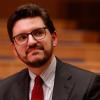The Vatican’s financial watchdog agency registered a three-fold increase in suspicious transactions undertaken in the city state’s financial institutions in 2015, marking 544 activities as questionable and freezing or halting movement of a total of some $2.4 million and 15.3 million Euros.
The Financial Information Authority, or AIF, says it also made 17 reports to the Vatican’s Office of the Promoter of Justice, for possible review of crimes such as fraud, tax avoidance, tax evasion, and "more serious financial crimes … such as market disruption in foreign states."
The watchdog agency revealed the statistics with the release of its fourth annual report Thursday. The agency, which was started by Pope Benedict XVI in 2010 but continued and strengthened under Pope Francis, has been working to bring the Vatican’s diverse set of financial organizations into compliance with international standards.
Thursday’s release comes as the city state’s financial dealings have again been in the spotlight, with news in recent weeks that the Vatican had suspended an external audit it had contracted with the international firm PricewaterhouseCoopers.
Francis also made the unusual and previously unannounced step of personally visiting two of the Vatican’s main financial entities Thursday morning, heading both to the new Secretariat for the Economy, headed by Cardinal George Pell, and to the Administration of the Patrimony of the Holy See.
The watchdog agency said the increase in suspicious activity reports to 544 in 2015 from 147 in 2014 "was not due to a higher financial crime rate" but to a number of factors, including the closing of Vatican financial accounts no longer in compliance with the city state's new norms and the monitoring of customers' obligations under other countries' voluntary tax compliance programs.
The increase of suspicious activity was due to "in general, the strengthening of reporting mechanisms and supervised entities' increasing awareness of reporting obligations," says Tommaso di Ruzza, the agency’s director, in an introductory note to the 2015 report.
"Transparency and integrity in the financial sector are fundamental goals," says di Ruzza. "The pursuit of these goals is a strategic and operational duty but it is, first and foremost, a moral duty, considering the Holy See's mission in the world."
René Brülhart, the agency’s president, said at a press conference Thursday that the reporting statistics show "the system works and that measures have been put in place that these potential abuses … can be addressed."
"The system itself is efficient," said Brülhart.
Asked about those who might see the sharp increase in reports of suspicious activity not as a sign of success but of widespread questionable financial activity at the Vatican, Brülhart said that was a "very fair question."
"I would like to see the figure zero," said the president. "But this doesn’t reflect reality. Wherever you have financial transactions, financial activities, you always see something potentially suspicious."
"This is building a system amongst all the involved Vatican authorities," said Brülhart. "This is building a system. I think it’s very important to know that."
The Vatican watchdog also says in its report that all of the accounts held at the long-controversial so-called Vatican bank, the Institute for the Works of Religion, were reviewed by the end of October 2015 and that 4,800 accounts at the institution were closed.
Di Ruzza said that the process of closure of accounts at the bank, started in 2013 after the institute tightened regulations on who can hold money there, has now come to a conclusion.
Brülhart emphasized the cooperation his watchdog agency reported with international authorities in the 2015 report, which states that information was exchanged abroad in 308 cases compared to 103 in 2014.
The Vatican also signed new separate international tax compliance agreements with both Italy and the U.S. in 2015.
According to Vatican law, anyone moving assets greater than 10,000 Euros into or out of the city state must declare the transaction to the Gendarme Corps and the watchdog agency.
The 2015 report says 367 declarations were made identifying some 9.7 million Euros moving into the Vatican and 1,196 declarations were made identifying some 24.1 million Euros moving out that year.
The Financial Information Authority is one of the Vatican’s several financial agencies.
Francis created the Secretariat for the Economy in 2014 to place the agencies under one centralized office, putting Pell in charge of the new operation. The Secretariat is overseen by the Council for the Economy, a group of eight cardinals or bishops and seven lay people.
The Council approved the PricewaterhouseCoopers audit in late 2015. Vatican spokesman Jesuit Fr. Federico Lombardi said April 21 that the audit was suspended following "detailed studies of some aspects relative to the agreement" reached with the firm.
Speculation for the reason of the suspension of the audit has centered on whether Pell or the Council may have made the agreement in a way that violated other Vatican processes or ruffled the feathers of others in leadership in the city state.
Prior to the creation of the Council and Secretariat for the Economy, the Administration of the Patrimony of the Holy See was tasked with overseeing property owned by the Holy See and administering the funds given to the Vatican by the Italian government as part of the Lateran Treaty of 1929.
Pell has since transferred much of the patrimony’s work into his secretariat and has said its remaining staff is now tasked with serving essentially as the Vatican’s treasury.
[Joshua J. McElwee is NCR Vatican correspondent. His email address is jmcelwee@ncronline.org. Follow him on Twitter: @joshjmac.]




